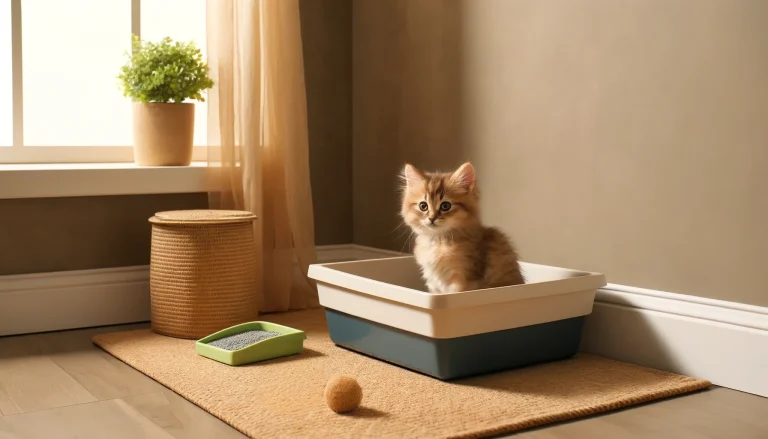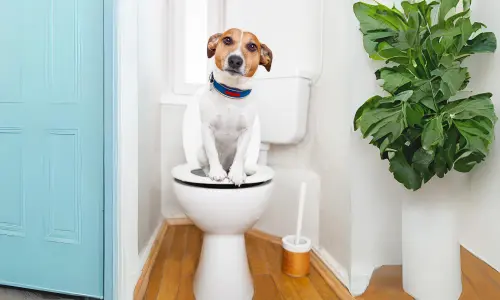Learn essential tips for Kitten Litter Box Training and teach your kitten to use the litter box with ease. Ensure a clean and happy home.
Introduction
Welcoming a new kitten into your home is a joyous occasion filled with playful moments and boundless curiosity. However, this new addition also brings a set of responsibilities, one of the most important being litter box training. Proper litter box training is crucial for maintaining a clean and harmonious living space, and it sets the foundation for your kitten’s good habits in the future.
Litter box training can sometimes be challenging, but with the right approach and a bit of patience, your kitten will soon master this essential skill. From selecting the right litter box and litter to ensuring the proper placement and using positive reinforcement, each step plays a vital role in your kitten’s success.
In this comprehensive guide, we’ll walk you through the entire process, providing practical tips and insights to help you and your kitten achieve litter box success. Let’s dive into the world of kitten training and make your home a cleaner, happier place!
Why It’s Important
Training your kitten to use the litter box is an essential aspect of pet ownership, and it carries several significant benefits for both you and your furry friend. Understanding these benefits can help you appreciate the importance of this process and motivate you to approach it with patience and dedication.
First and foremost, litter box training is crucial for maintaining a clean and odor-free home. Kittens, like all pets, need to relieve themselves regularly, and without proper training, this can lead to accidents around the house. These accidents are not only unpleasant to clean but can also cause lasting damage to carpets and furniture. By teaching your kitten to use the litter box, you can prevent these mishaps and keep your living space neat and sanitary.
Moreover, proper litter box use is vital for your kitten’s health and hygiene. Cats are naturally clean animals, and providing a designated place for them to go to the bathroom helps them maintain their grooming habits. A clean litter box reduces the risk of infections and illnesses that can arise from unsanitary conditions. Regular use of the litter box also allows you to monitor your kitten’s health, as changes in their bathroom habits can be an early indicator of medical issues.
Another important reason for litter box training is the positive impact it has on your relationship with your kitten. Successful training fosters a sense of trust and understanding between you and your pet. It shows your kitten that their needs are being met in a consistent and caring manner, which can strengthen your bond. Additionally, a well-trained kitten is more likely to feel secure and comfortable in their environment, reducing stress for both of you.
In summary, litter box training is not just about keeping your home clean—it’s about ensuring your kitten’s well-being and fostering a harmonious relationship. With a clean and accessible litter box, your kitten will develop good habits that will benefit them throughout their life, creating a happy and healthy home for everyone involved.

Choosing the Right Litter Box
Selecting the right litter box is the first step in successful training. There are various types of litter boxes available, including open, covered, and self-cleaning models. Consider the size of your kitten and the space available in your home. For small kittens, an open litter box with low sides is often the best choice, as it allows easy access.
When deciding between covered and uncovered litter boxes, think about your kitten’s preferences. Some kittens feel more secure in a covered box, while others may prefer an open one. A larger box will also be necessary as your kitten grows, so plan for future needs.
Selecting the Best Litter
Choosing the right litter for your kitten is a key component of successful litter box training. With so many options available, it can be overwhelming to decide which type of litter will work best for both you and your furry friend. Here, we’ll break down the different types of litter and what you should consider when making your selection.
Clumping vs. Non-Clumping Litter
One of the first decisions you’ll need to make is whether to use clumping or non-clumping litter. Clumping litter is designed to form solid clumps when your kitten urinates, making it easier to scoop out waste and keep the litter box clean. This type of litter is typically made from bentonite clay and is very popular among cat owners for its convenience.
Non-clumping litter, on the other hand, does not form clumps. It absorbs moisture and odor but requires more frequent changing. This type of litter can be made from a variety of materials, including clay, pine, and recycled paper. While it may require a bit more maintenance, some kittens and owners prefer non-clumping litter for its natural feel and often lower dust levels.
Scented vs. Unscented Litter
Another consideration is whether to use scented or unscented litter. Scented litters are formulated to mask the odor of waste, making the litter box area more pleasant for humans. However, some kittens may be sensitive to strong scents and could avoid using the litter box if the smell is too overpowering.
Unscented litters, while less effective at odor control, are often preferred by kittens and are less likely to cause respiratory issues. If you choose unscented litter, regular cleaning is essential to keep odors at bay.
Material Considerations
The material of the litter is also important. Traditional clay litters are highly absorbent and effective at controlling odor, but they can be dusty and may not be environmentally friendly. Natural litters made from materials like corn, wheat, or pine offer a more eco-friendly option and are often biodegradable. These litters tend to be less dusty and can be a better choice for kittens with respiratory sensitivities.
Dust Levels
Kittens, especially those with sensitive respiratory systems, can be affected by the dust from certain types of litter. High-dust litters can cause sneezing and discomfort. If your kitten shows signs of irritation, consider switching to a low-dust or dust-free option to ensure their comfort and health.
Texture and Comfort
Lastly, consider the texture of the litter. Kittens have delicate paws, and some may be particular about what feels comfortable underfoot. Softer, finer litters are generally more appealing to kittens than coarser varieties. Pay attention to your kitten’s behavior—if they seem hesitant or uncomfortable using the litter box, the texture of the litter might be the issue.
Location Matters
The location of your kitten’s litter box is crucial to successful training. Placing the litter box in the right spot can make all the difference in encouraging consistent use. Choose a quiet, low-traffic area where your kitten feels safe and undisturbed. Avoid busy or noisy areas, as kittens can be easily startled and may avoid using the box if they feel stressed or threatened.
Accessibility is also key. Make sure the litter box is easily reachable from the areas where your kitten spends most of their time. If your home is large or has multiple levels, consider placing multiple litter boxes in different locations to ensure convenience. Additionally, avoid placing the litter box near their food and water bowls, as kittens prefer to keep their eating and bathroom areas separate.
Initial Introduction and Positive Reinforcement
Introducing your kitten to the litter box for the first time is a critical step in the training process. Begin by placing your kitten in the litter box as soon as you bring them home. This initial introduction helps familiarize them with the new environment and the litter box’s purpose.
It’s best to place your kitten in the litter box after meals and naps since these are times when they are most likely to need to go. Gently guide them to scratch the litter with their paws, showing them how to dig. This action can stimulate their natural instincts to bury their waste, making them more likely to use the litter box.
Patience is key during this phase. If your kitten doesn’t use the litter box immediately, don’t worry. Simply continue to place them in the box at regular intervals and after they exhibit behaviors that suggest they need to go, such as sniffing around or scratching at the floor.
Positive reinforcement is a powerful tool in litter box training. Whenever your kitten uses the litter box correctly, reward them with praise or a small treat. This will help build positive associations with the behavior and encourage them to repeat it. Consistent, gentle guidance paired with positive reinforcement makes the training process smoother and more enjoyable for your kitten.
It’s essential to maintain a calm and supportive environment. Avoid scolding your kitten if they have accidents outside the box, as this can create fear and reluctance. Instead, gently place them in the litter box to reinforce where they should go. Consistent, gentle guidance will help your kitten understand and feel comfortable using their litter box.
Positive reinforcement not only encourages good habits but also strengthens the bond between you and your kitten. By associating the litter box with positive experiences, your kitten will feel more confident and secure in their new environment, making the training process more effective and enjoyable for both of you.
Common Challenges
Litter box training can sometimes present challenges, even for the most diligent pet owners. Understanding these potential issues and how to address them is crucial for successful training. Here are some common challenges you might encounter and strategies to overcome them.
Reluctance to Use the Litter Box
One of the most common challenges is a kitten’s reluctance to use the litter box. This reluctance can stem from a variety of reasons, including discomfort with the litter type, an unsuitable location, or even a dirty box. If your kitten avoids the litter box, try experimenting with different types of litter to see if they have a preference for a particular texture or scent. Additionally, ensure the box is clean and in a quiet, accessible location where your kitten feels safe.
Frequent Accidents
Accidents outside the litter box can be frustrating but are often part of the learning process. If your kitten has frequent accidents, consider if the box is too far away from their main play or rest areas. Young kittens may not have the bladder control to travel long distances. Place multiple boxes around your home to increase accessibility and reduce the chances of accidents.
Inconsistent Use
Inconsistent use of the litter box can also be a challenge. This behavior might occur if your kitten is feeling stressed or if there are changes in their environment, such as a new pet or rearranged furniture. To address this, maintain a consistent routine and keep the litter box in the same location. Providing a calm, stable environment can help reduce stress and encourage consistent use.
Digging and Playing in the Litter Box
Kittens are naturally curious and playful, which sometimes leads to excessive digging or playing in the litter box. While this behavior is generally harmless, it can be messy. To minimize this, ensure the litter box is appropriately sized and filled with an adequate amount of litter. If the behavior continues, gently redirect your kitten’s attention with toys or interactive play outside of the litter box.
Health Issues
Occasionally, litter box challenges can indicate health issues. If your kitten suddenly stops using the litter box or has difficulty urinating or defecating, it may be a sign of a medical problem such as a urinary tract infection or gastrointestinal issue. In such cases, consult your veterinarian promptly to rule out any health concerns and get appropriate treatment.
By recognizing and addressing these common challenges, you can make the litter box training process smoother for both you and your kitten. Patience, observation, and consistent care are key to overcoming these hurdles and ensuring your kitten develops good litter box habits.
Consistency is Key
Consistency is crucial in litter box training. Establish a routine by taking your kitten to the litter box at regular intervals, especially after meals and naps. This helps reinforce the habit and makes it easier for your kitten to understand where they should go. Keep the litter box in the same location to avoid confusing your kitten. Regular cleaning is also essential; a clean box is more inviting and encourages consistent use. Patience and persistence are vital—training can take time, and occasional accidents are normal. By maintaining a steady routine and offering gentle guidance, your kitten will develop reliable litter box habits that ensure a clean and happy home.
Cleaning and Maintenance
Regular cleaning and maintenance of the litter box are essential for encouraging your kitten to use it consistently. A clean litter box is more inviting and helps maintain good hygiene, reducing the risk of infections or unpleasant odors. Scoop out waste daily to keep the litter fresh and odor-free. It’s also important to change the litter completely at least once a week, or more often if you have multiple kittens.
When cleaning the litter box, use mild soap and water to avoid harsh chemicals that could deter your kitten from using it. Ensure the box is thoroughly dried before adding fresh litter. Consider using a litter mat outside the box to catch stray litter and minimize mess.
By keeping the litter box clean and well-maintained, you create a pleasant environment for your kitten, making them more likely to use it regularly and ensuring a harmonious living space for everyone.
Conclusion
Teaching your kitten to use the litter box requires patience, consistency, and positive reinforcement, but the effort is well worth it. By choosing the right litter box and litter, placing the box in a suitable location, and maintaining good cleaning habits, you can make the process smoother and more effective. Remember, every kitten is different, and it might take some time for them to adjust. Stay patient and supportive, and don’t be discouraged by occasional setbacks.
Successful litter box training not only keeps your home clean but also promotes your kitten’s health and strengthens your bond. With the right approach and dedication, your kitten will develop good habits that will benefit them throughout their life, creating a happy and healthy home for both of you.
Thank you for following along with this guide. We hope these tips and insights help you and your kitten achieve litter box success. Happy training!
FAQs
What should I do if my kitten refuses to use the litter box?
If your kitten refuses to use the litter box, try changing the type of litter or moving the box to a different location. Ensure the box is clean and accessible. Patience and consistency are key.
How often should I clean the litter box?
It’s best to scoop the litter box daily and change the litter completely once a week. Regular cleaning helps prevent odors and keeps the box inviting for your kitten.
Can I use scented litter for my kitten?
While scented litter can help control odors, some kittens may prefer unscented options. If your kitten shows reluctance, try switching to an unscented variety.
What is the best type of litter box for a kitten?
An open litter box with low sides is usually best for kittens, as it allows easy access. As your kitten grows, you can transition to a larger, covered box if desired.
How can I prevent my kitten from having accidents?
Take your kitten to the litter box regularly, especially after meals or naps. Reward them for using the box correctly, and be patient and consistent with training.
Why is my kitten digging excessively in the litter box?
Excessive digging can be a sign of curiosity or playfulness. Ensure the litter box is the right size and has enough litter. If the behavior continues, consult a vet to rule out any health issues.
Visit Our Blog for More Tips and Advice
Thank you for reading our guide on Kitten Litter Box Training. For more helpful tips and advice on how to care for your furry friends, be sure to visit our Pet Care Guide. Our blog is filled with valuable information to help you keep your pets happy and healthy. Explore our articles and become the best pet parent you can be!


